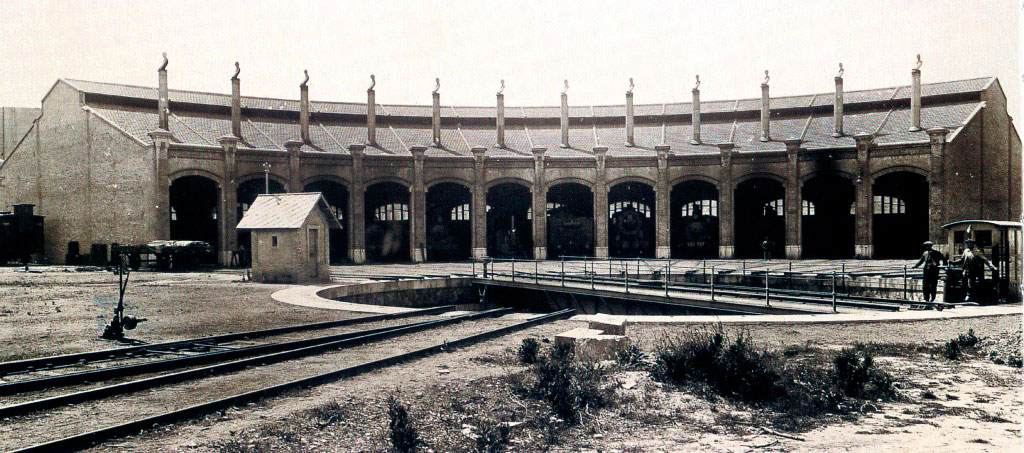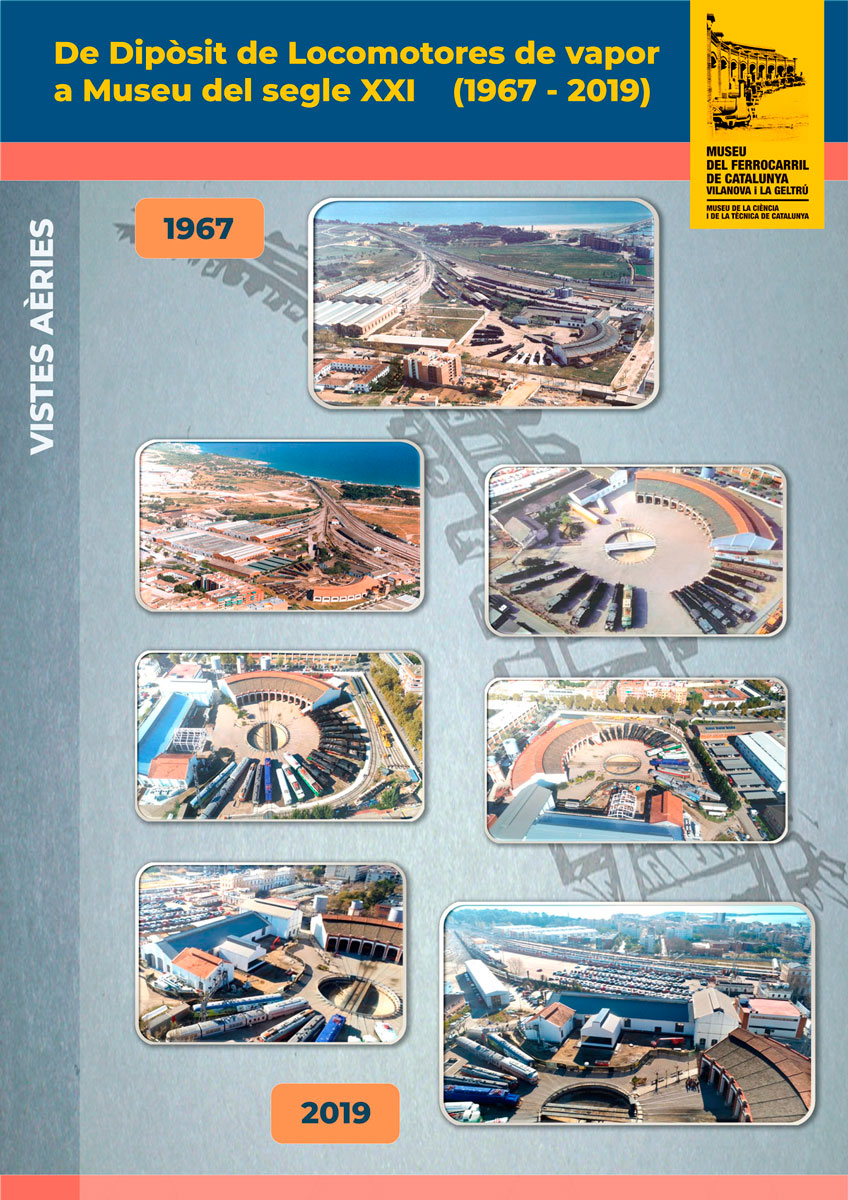
From prehistory to the genesis of the Museum
The genesis of the Railway Museum of Catalonia dates back to
1972. Part of an initiative of the Association of Friends of the
Railway of Barcelona, following the celebration of the XIX
Congress of European Railway Modelers (MOROP) for this reason it
was decided to gather in Vilanova a wide exhibition of steam
locomotives.
The reason for choosing the capital of Garraf was the existence
of an old locomotive depot that had stopped working in 1967 and
that allowed to have a rotating bridge, water tanks and a
roundabout to store the machines. The Vilanovinas Facilities had
great activity from the late nineteenth century to the middle of
the XXI, being a fact that they attracted railway employees from
all over the state to this city, which came to have employees to
more than 900 professionals. Without a doubt, the railway marked
the contemporary history of the population.
Once the initiative to make an exhibition on the tracks of the
Vilanova railway complex was approved, Renfe moved vehicles from
different places on the peninsula for exhibition in the city.
After the International Congress, most of this material would be
parked, being the embryo of the future museum that would still
take time to materialize.
Read more >>
The Museum opened its doors on August 3, 1990 by the will of the City Council and Renfe, but without a global intervention plan, nor an organization, nor a fund that would turn the old warehouse and the service building into a real Museum. The key factor that made possible its evolution and development in the early years was the passion, tenacity, generosity and drive of different people and experts in the railway world. From 1993, when Renfe passed the management to the cultural foundation specialized in the railway, its operation began to be professionalized.
Renfe in 1993 entrusted the management to the Spanish Railways Foundation. It was from that year when the existence of the Museum as such was formalized, assigning some first economic and human resources, setting opening hours to the public, prices, an operating protocol, a first inventory and the creation of the audio-visual "Climb the train of history" that won the international Laus award for excellence in audio-visual communication.

From 150th anniversary to 2008
In 1998, the 150th anniversary of the Barcelona-Mataró front
line was celebrated and the Foundation considered the
commemoration as the opportunity to also give a boost to the
Museum. From the following year, a new program of exhibitions
and activities is established for different audiences,
especially for the school. It is also when the Great Nave, built
in the origins of the Vilanova railway (1881), is definitively
incorporated into the Museum. In 1999, it was registered in the
Register of Museums of the Generalitat of Catalonia with the
number 114.
In the following ten years, a sustained work of consolidation of
the equipment as a dynamic space at the service of society and
the establishment of external links is carried out, as well as
preservation and heritage documentation and architectural
rehabilitation. Different areas were created in the commissary
building, such as the library-newspaper library, the archive and
the reserve.
It was in this period when two historic buildings were
rehabilitated and recovered: the old warehouse of the supply
workshop, such as Espacio Siglo XXI (2000), and one of the water
tanks, such as Espacio Gumà (2006). In the same way, the
infrastructure would be increased with three new roads to be
able to grow and increase the number of preserved vehicles.
Sixteen vehicles were added to the initial collection, among
other heritage elements; ten walkways would be built or adapted
for the visit to the material. The Vall de Núria Park was
installed outside, a gift from FGC on the 75th anniversary of
the Cremallera; and the great mural of the sculptor Josep Maria
Subirachs created for the Sants station was transported. In
terms of restorations, there were more than 25 interventions in
historical rolling stock until 2008.
Despite the actions carried out in this period in different
areas (educational, communication, conservation, documentation
...) the essential investments to convert the facilities of the
old warehouse into a true accessible and modern museum were
still pending.
The energy of collaboration
After these years of progress, it is during the economic
crisis when the turning point occurs. The decisive cooperation
in the project of a number of people and the institutions they
represented made it possible to channel the future Museum. In
the following link, you can consult the organizations that
collaborate in making possible the dream of promoting a museum
of the railway of the XXI century.
In 2007, the director of the Territorial System of the mNACTEC,
Eusebi Casanelles, granted a grant from the Generalitat of €
30,000 for the preparation of a comprehensive draft. The
collaboration of the heritage area of the ADIF, as head of the
institutions, allowed making a Master Plan to convert the
historic railway complex into a real Museum. The architect José
Ramón Pastor, responsible for the rehabilitation of the Estación
de Francia, was the one who, on behalf of Adif, directed all the
projects and works of the following years that the architect,
Jordi Roig, executed.
In the same period, the “vilanoví” deputy in the Congress of
Deputies, Carles Campuzano, after a visit to the Museum in which
he detects the potential of this asset of the territory,
presents an amendment to the General State Budgets from which he
would derive a contribution of € 450,000 in 2009 and the same
amount in 2010. The € 900,000 allowed emergency rehabilitations
in two of the most emblematic and deteriorated buildings: the
Bridge-Crane Shed and the Rotunda, as well as the realization of
two executive projects to be able to continue in the future the
interventions.
Read more >>
In the following years, the works of the Ministry of Development were executed, keeping the Museum open. The result was a steady growth of visitors, most notably since 2013, despite the complex economic context and the general decrease in audiences of most museums.
In the climate of cooperation established at the end of the first decade of the XXI century, the same year 2013 an Agreement was signed between the Foundation and the City Council for the shared use of the Bridge-Crane Ship until 2019. An innovative and pioneering agreement in the country's museums that meant a remarkable municipal investment in the oldest and most unique Nave of the Museum and the opportunity to be used by opening it to the city.
Two milestones have just boosted the Museum's educational vocation. On the one hand, the start of the Master's Degree in Railway and Electric Traction Systems of the Campus of the Polytechnic University of Catalonia in Vilanova i la Geltrú, made possible by the close cooperation of the UPC with the Foundation and the Museum. A postgraduate course was a decisive step for the educational capital of the railway in Catalonia. In fact, three years later also in Vilanova would begin to be taught for the first time in Spain an average degree of dual professional training in maintenance of railway vehicles. With these studies, the capital of Garraf is positioned as the first training center for professionals in the railway sector in Catalonia. The educational task of the Museum with the support of the Municipal Institute of Education of Barcelona and Vilanova or with the Garraf Pedagogical Resource Center has contributed decisively to the knowledge of the railway system.
It will also be in this period when the creation of the collective of volunteers of the Museum is consolidated, a proposal that had been years in the making. A small group of railway retirees began collaborating on restoration work in 2006. The gradual incorporation of people (not always originally linked in the world of trains) for activities of documentation, dissemination or attention to visitors, would lead to the constitution in 2009 of the Association of Partners and Collaborators of the Museum (SiC). One of its main milestones was the recovery and rehabilitation of the valuable American car Harlan, a complex restoration that involved an investment of eight years of work. This vehicle could be incorporated into the exhibition collection as one of its main jewels. They were awarded the Bonaplata Prize 2015, a distinction awarded every year by the Associació del Museu de la Ciència i de la Tècnica i d’ Arqueologia Industrial de Catalunya, in the category of collaborating entity, in recognition of their work in the enhancement of the industrial, technical and scientific heritage.